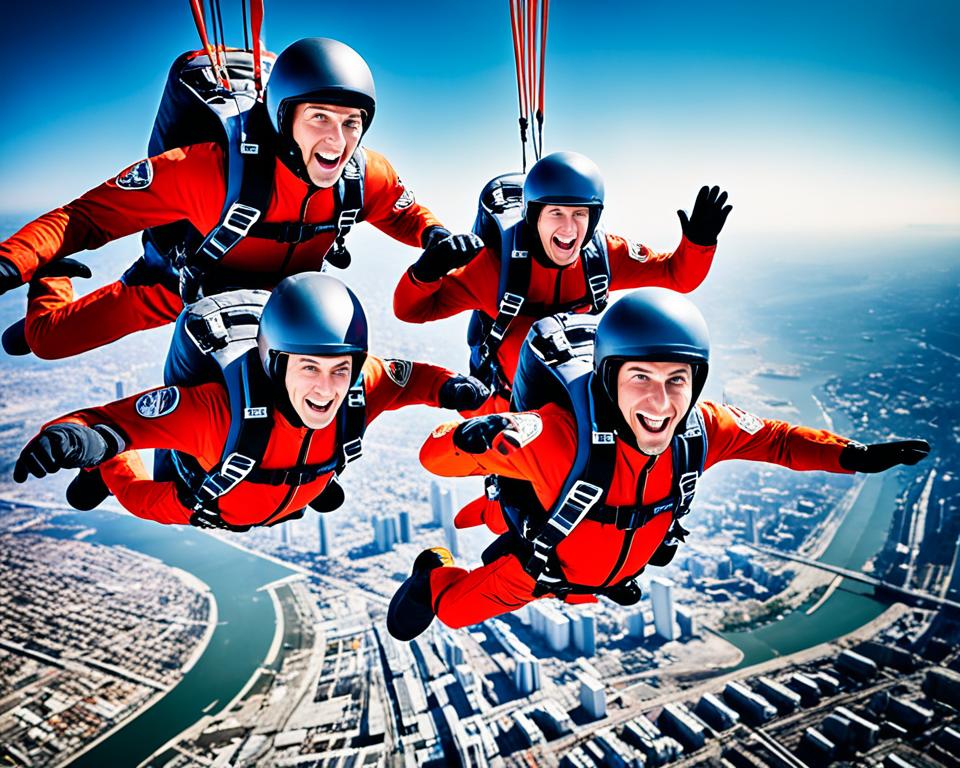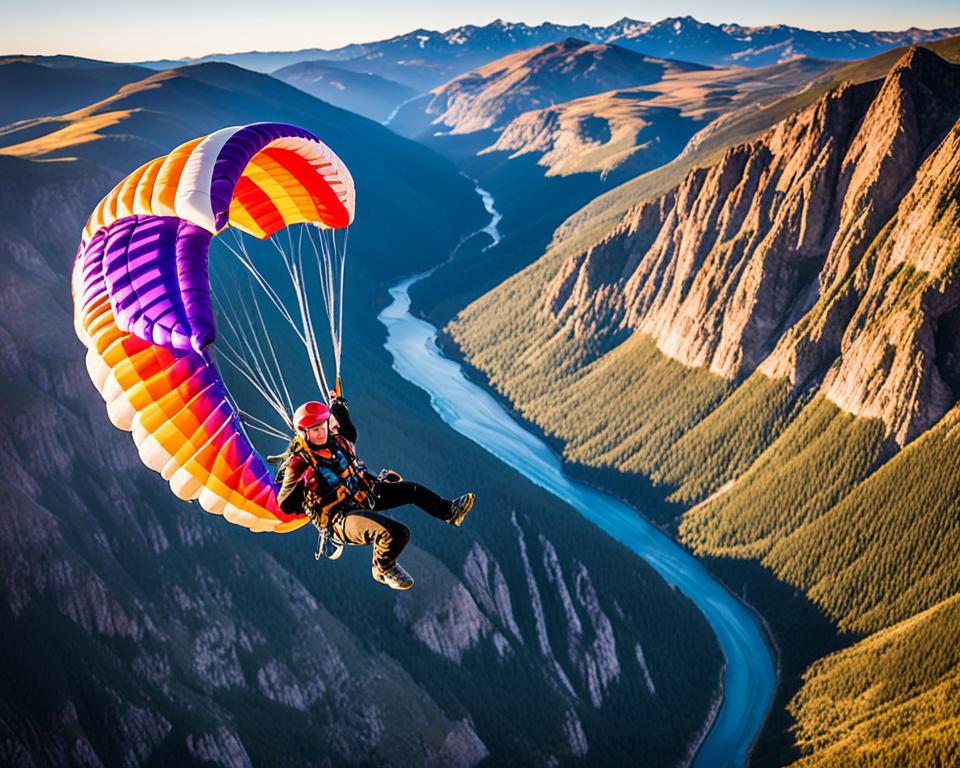Extreme parachuting, known as skydiving or BASE jumping, is a sport full of thrill. It attracts adventure lovers from all over the world. Jumping from high places, like aircraft or bridges, is part of it. Then, you feel the excitement of falling freely before opening the parachute to land. This sport allows people to do exciting moves in the air, go to incredible heights, and feel the joy of beating gravity. This article will take you through the exciting world of extreme parachuting. We will look at its history, different types, the gear needed, training, and the communities that love this daring sport.
Read interesting things at : trainwithnexus
Key Takeaways
- Extreme parachuting, also known as skydiving or BASE jumping, is an adrenaline-fueled adventure sport.
- Participants jump from aircraft, buildings, bridges, or other elevated structures and experience the rush of freefall before deploying a parachute.
- The sport enables daring aerial maneuvers, record-breaking heights, and the ultimate rush of defying gravity.
- This article explores the history, types, equipment, training, and growing communities of extreme parachuting.
- The sport captivates thrill-seekers worldwide, pushing the boundaries of human flight.
Introduction to Extreme Parachuting
Extreme parachuting, known as skydiving or BASE jumping, is thrilling. It’s loved worldwide by thrill-seekers. It involves jumping off high places and feeling the excitement of freefall. Then, a parachute is used for a safe landing. This sport lets you fly like never before, with participants trying daring moves and new jump spots.
Defining the Sport
Extreme parachuting means jumping from high places and freefalling. Then, you use a parachute to safely reach the ground. There are many ways to do this, such as skydiving, BASE jumping, and high-altitude jumps. Each method has its own excitement and challenges.
History and Evolution
The story of extreme parachuting starts in the early 1900s. At first, it was for the military. Since then, it has grown as adventurers seek new heights. From the first successful jump in 1783 to today’s BASE jumps, it has always excited daredevils.
The Thrill and Adrenaline Rush
Extreme parachuting offers a unique thrill and freedom. Jumpers often say it feels like time slows down in freefall. The mix of skill, focus, and courage needed makes every jump rewarding. It’s the ultimate sport for those craving excitement.
Types of Extreme Parachuting
Extreme parachuting has many types, each with its own thrills and challenges. The main ones include skydiving, BASE jumping, and high-altitude jumps.
Skydiving
Skydiving is widely known and loved. People jump from planes or helicopters and feel the thrill of freefall. They reach speeds up to 200 mph, doing tricks and stunts before landing safely.
BASE Jumping
BASE jumping is riskier and more specialized. Jumpers leap off Buildings, Antennas, Spans (like bridges), and Earth (cliffs). Unlike skydivers, they use smaller parachutes to land in tight spaces.
High-Altitude Jumps
High-altitude jumps are the hardest. Jumping from over 30,000 feet tests both skills and gear. Jumpers enjoy long freefalls, doing tricks, before opening their chutes.
Extreme Parachuting Equipment
Extreme parachuting demands special gear to keep jumpers safe and on track. This gear centers around the parachute, which varies for different jump styles and levels. Jumpers depend on these advanced systems for a safe landing after doing daring feats.
Parachutes and Gear
The parachute is key for those into extreme parachuting. It’s designed for top-notch performance, stability, and dependability. Skydivers have both a main and a backup chute. BASE jumpers use chutes built for quick open times and nimble flight.
Besides the parachute, gear also features tailored harnesses and altimeters. Harnesses spread out the impact, offering a snug and safe experience. Altimeters keep watch on altitude, crucial for well-timed chute deployment.
Safety Considerations
Safety stands above all in extreme parachuting, requiring strict safety checks and contingency plans. This means detailed gear checks, emergency procedures, and backup safety items. Participants are trained to quickly spot and handle any trouble that could arise.
| Equipment | Purpose | Key Features |
|---|---|---|
| Parachute | Primary deployment system | Stability, control, reliability |
| Backup Parachute | Emergency deployment system | Redundancy, quick deployment |
| Harness | Secure attachment to parachute | Comfort, load distribution |
| Altimeter | Altitude monitoring | Precision, visibility |
| Other Safety Gear | Enhance protection and stability | Helmet, gloves, protective suits |
Training and Preparation
Extreme parachuting is serious, and you need lots of training and lessons before you jump. Beginners start with basic training on the ground. They then move to actual jumps with a supervisor and learn more and more.
Acquiring Proper Training
To be great at extreme parachuting, you start with a complete training course. You cover a lot, like safe jumping and what to do in an emergency. This training is key for making sure you’re ready for the sport.
Physical and Mental Readiness
To succeed, you need to be in great shape and ready in your mind too. You must be physically strong to manage the jumps. Mentally, you need to handle fear and be quick to make decisions up in the air.
Preparing well with both the right training and personal readiness is crucial. It lets you enjoy extreme parachuting while staying safe and in control.
Extreme Parachuting Destinations
Extreme parachuting lovers chase thrilling jumps all over the world. There are many popular drop zones and unique, challenging locations that attract adventurers. From the Swiss Alps’ majestic peaks to Australia’s sunny views, the globe is full of adrenaline-packed adventures for the boldest.
Popular Drop Zones
Skydiving locations like Queenstown in New Zealand are famous for their stunning views and high jumps. Then, there’s Interlaken, Switzerland, where you can leap from cliffs and see snow-capped mountains as you fall. In the U.S., places like Skydive Perris in California and Skydive Chicago in Illinois are top choices for daring divers.
Unique and Challenging Locations
For those who crave real adventure, extreme parachuting destinations offer a thrilling challenge. Try base jumping sites around the globe, like the Burj Khalifa in Dubai or the Kuala Lumpur Tower in Malaysia. Jump from the world’s highest places and feel the ultimate thrill of freedom. Other amazing spots include the Kjerag Bolt in Norway, the Moab Canyon in Utah, and the Eiger North Face in Switzerland. Each is a perfect mix of stunning scenery and pure excitement.
Extreme Parachuting: A Thrilling Adventure Sport
Extreme parachuting is all about the heart-pounding freefall and daring aerial feats. It’s a thrilling adventure sport loved by daredevils worldwide. Whether it’s skydiving‘s excitement, the challenge of BASE jumping, or high-altitude jumps, it mixes skill, bravery, and a pure adrenaline rush.
Extreme parachuting is for thrill-seekers looking for next-level excitement. It’s a daring sport that changes your view on flight. The adventure starts from the jump to the parachute opening, offering pure excitement and a sense of achievement.
| Discipline | Description | Adrenaline Factor |
|---|---|---|
| Skydiving | Jumping from aircraft, such as planes or helicopters, and experiencing the exhilarating freefall before deploying the parachute. | High |
| BASE Jumping | Leaping from fixed objects like buildings, bridges, or cliffs, and navigating the freefall before opening the parachute. | Extremely High |
| High-Altitude Jumps | Ascending to record-breaking heights before making the jump and executing intricate aerial maneuvers during the freefall. | Exceptionally High |
If you’re up for the challenge, extreme parachuting is your chance to push the limits. It’s your shot at the ultimate thrill of daredevil activities.
Aerobatic Maneuvers and Freefall Formations
Extreme parachuting offers more than just the rush of freefall. It’s about the high-level skills and stunning aerial moves. Skilled skydivers and BASE jumpers can do amazing aerobatic maneuvers. These include barrel rolls and loops, which look like they’re beating gravity.
Skilled Techniques
Performing skydiving techniques with accuracy and grace is what sets the pros apart. They spend years practicing to flawlessly do aerial acrobatics. These experts can smoothly switch between different freefall formations. They do stunts that thrill watchers and other thrill-seekers.
Team Formations and Coordination
Extreme parachuting highlights the need for team coordination to pull off daredevil stunts. Teams of seasoned skydivers and BASE jumpers work as one. They match their moves and positions, creating breathtaking aerial shows in mid-air.
Safety Protocols and Emergency Procedures
Extreme parachuting is thrilling but comes with risks. Participants follow strict safety protocols and emergency procedures. This is to cut the dangers and keep them safe.
Risk Management
Being safe in extreme parachuting means looking at risk in every way. Before jumping, they check everything and have a second parachute ready. They also do emergency drills often. This helps them be ready for any risks and have the right safety equipment.
Emergency Protocols
If something goes wrong, parachuting experts know what to do. They learn how to stay in control, get their parachutes open right, and land safely in an emergency. Training a lot teaches them to act quick and right under stress.
| Safety Protocols | Emergency Procedures |
|---|---|
|
|
The Psychology of Extreme Parachuting
Extreme parachuting is more than just jumping and freefalling. It needs serious physical skills and a strong mind. Jumpers must have both mental toughness and focused minds to handle the dangers and thrills.
Mental Toughness and Focus
Top parachutists focus intensely during the most important parts of their jumps. They make quick choices, use advanced techniques, and stay calm in high-stress moments. Their mental toughness helps them leap over fears and enjoy the sport’s excitement while staying alert.
Overcoming Fear and Anxiety
Jumping from tall heights is scary, and even the bravest have moments of doubt. Parachutists develop ways to calm their nerves to jump well. By training hard, imagining success, and knowing safety steps, they get past fears that might stop them from doing their best.
The psychology of extreme parachuting is key in this sport, making adrenalin-seekers stand out from the crowd. With a mix of mental toughness, unwavering focus, and control over their fears, parachutists break flight limits and feel the incredible excitement of flying against gravity.

Extreme Parachuting Communities and Events
The world of extreme parachuting is full of passionate and close groups. They love the sport and do everything from local meets to global events. These gatherings help them improve, show off their skills, and build bonds.
Regional and Global Gatherings
Local and extreme parachuting enthusiasts plan events that bring people from nearby areas. Here, they can hang out, learn from each other, and have fun competing. This strengthens their community ties.
At a bigger level, international conferences let parachuting fans from everywhere meet. They join workshops and talks, learn about new gear, and find amazing places to jump. These events are full of excitement and learning.
Competitions and Exhibitions
There’s also a competitive side to extreme parachuting, with events that wow crowds. These can be solo flights showing off skills or group jumps with amazing formations. Fans and jumpers love watching the top athletes go.
Outside of competition, there are also exhibitions to enjoy and learn more about the sport. They include demos, gear displays, and talks. They’re a great way to feel the parachuting culture and spark interest in others.
| Regional Events | Global Gatherings | Competitions | Exhibitions |
|---|---|---|---|
| Local skydiving competitions | International parachuting conferences | Acrobatic performance competitions | Daredevil showcase events |
| BASE jumping meetups | Global parachuting summits | Formation jumping challenges | Equipment and technology demonstrations |
| High-altitude jump gatherings | Worldwide parachuting conventions | National and international championships | Cultural celebrations of the sport |
Legal and Regulatory Considerations
Extreme parachuting is an adventure sport. It’s regulated by legal regulations and safety guidelines to protect participants. Around the world, various governing bodies and agencies have set rules. These rules focus on licensing requirements, including mandates for insurance and liability management.
To take part in extreme parachuting, people often need special permits. They must go through specific training and show they know how to jump safely. These rules are in place to ensure safety.
Extreme parachuting requires insurance because it’s risky. With the right insurance, participants get help with medical, equipment, and legal costs if things go wrong.
Following legal regulations and safety guidelines is key. It’s not just about personal safety; it’s about protecting the whole parachuting community. Doing so helps keep the sport safe and enjoyable for everyone.
The Future of Extreme Parachuting
The extreme parachuting world keeps growing. The future of the sport looks bright, with many exciting changes coming. New technology is key in shaping these developments.
Advancements in Technology
New safety innovations and better gear are making extreme parachuting more popular and accessible. High-tech parachutes, smart sensors, and real-time data make it safer for all jumpers. This includes both experienced ones and those just starting.
Today’s technological advancements change the game, promising more thrilling aerial feats in the future of extreme parachuting. There are advanced control systems and smart automated deployment systems. These innovations are challenging the boundaries of human flight and the thrill of the experience.
Growing Popularity and Accessibility
Extreme parachuting‘s rise in popularity is making it more accessible. Better training, clear rules, and more equipment are available. These changes mean more people can join this thrilling adventure sport.
The evolution of the sport will bring extreme parachuting to even more fans. It aims to create a global community of brave aerial acrobats.

| Key Trends | Impact on the Future |
|---|---|
| Technological Advancements | Improved safety, gear, and user-friendly features driving growing popularity and accessibility of extreme parachuting |
| Expanding Global Reach | Increased availability of training, equipment, and events fostering a global community of parachuting enthusiasts |
| Innovative Safety Protocols | Enhanced safety innovations and risk management strategies enabling more daredevil activities and aerial feats |
| Evolving Sport Disciplines | Emergence of new parachuting disciplines and techniques pushing the boundaries of extreme parachuting |
Conclusion
Extreme parachuting keeps amazing daredevils and thrill-seekers everywhere. It’s becoming more popular with time. People love the thrill of skydiving and BASE jumping.
This sport shows skill, bravery, and excitement. New technology is making it easier to join in. The future will bring even more ways to enjoy this thrilling hobby.
The brave stunts and thrilling jumps in extreme parachuting show what humans can do. It’s all about challenging yourself and seeking the extraordinary. As the sport grows, new people are inspired to try it out.
As time goes on, extreme parachuting will get even better. Safety will improve, and it will attract more fans from around the world. No matter what you like, this sport offers something thrilling for everyone.
Sepak Takraw: The Captivating Olympic Journey of This Ancient Sport


